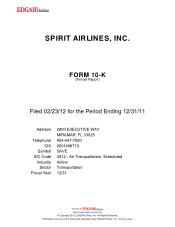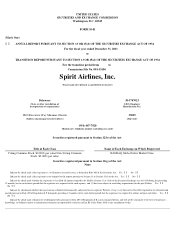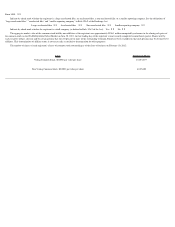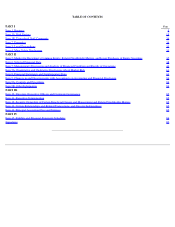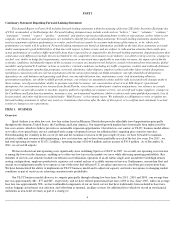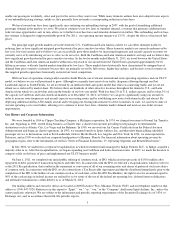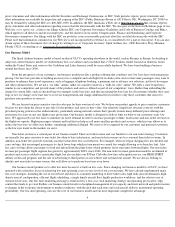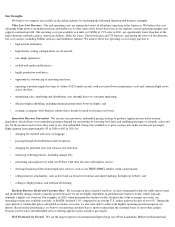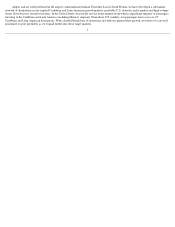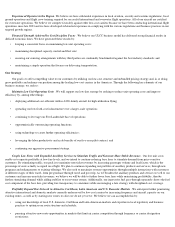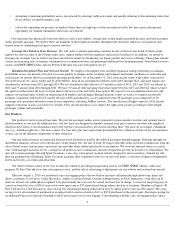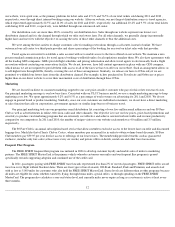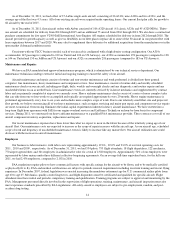Spirit Airlines 2011 Annual Report Download - page 7
Download and view the complete annual report
Please find page 7 of the 2011 Spirit Airlines annual report below. You can navigate through the pages in the report by either clicking on the pages listed below, or by using the keyword search tool below to find specific information within the annual report.
proxy statements and other information with the Securities and Exchange Commission, or SEC. Such periodic reports, proxy statements and
other information are available for inspection and copying at the SEC's Public Reference Room at 100 F Street, NE., Washington, DC 20549 or
may be obtained by calling the SEC at 1-800-SEC-0330. In addition, the SEC maintains a Web site at http://www.sec.gov that contains reports,
proxy statements and other information regarding issuers that file electronically with the SEC. We also post on the Investor Relations page of our
Web site, www.spirit.com , a link to our filings with the SEC, our Corporate Governance Guidelines and Code of Business Conduct and Ethics,
which applies to all directors and all our employees, and the charters of our Audit, Compensation, Finance and Nominating and Corporate
Governance committees. Our filings with the SEC are posted as soon as reasonably practical after they are filed electronically with the SEC.
Please note that information contained on our Web site is not incorporated by reference in, or considered to be a part of, this report. You can also
obtain copies of these documents free of charge by writing to us at: Corporate Secretary, Spirit Airlines, Inc., 2800 Executive Way, Miramar,
Florida 33025, or emailing us at: Corporate.Secretary@spirit.com .
Our Business Model
The Spirit Airlines business model is based on that of ULCCs operating elsewhere in the world, such as Ryanair in Europe. In deciding to
adopt our current business model, we studied many low-cost airlines and concluded that a ULCC business model focused on domestic routes
within the United States and routes to the Caribbean and Latin America could be successfully deployed. We have been building a business
around this thesis since 2006.
From the perspective of our customers, our business model provides a product offering that combines very low base fares with transparent
pricing. Our base fare provides everything necessary for a complete and safe flight but excludes extra services that some passengers may want to
purchase to enhance their travel experience, such as baggage, telephone booking, a premium seat or advance seat selection, and food, beverages
and other onboard items. We are not a “no frills” airline, rather we consider ourselves a “frills for a fee” airline. We offer a travel experience
similar to our competitors and provide many of the products and services offered as part of our competitors’ fares. Rather than embedding the
charge for certain frills, such as checked bags for example, in the base fare, and thus increasing the base fare for all customers whether they carry
bags or not, we charge a low base fare to cover air transportation and charge additional fees for frills to only those customers that choose to
purchase extra products or services.
We are focused on price-sensitive travelers who pay for their own travel costs. We believe our product appeals to price-
sensitive customers
because we give them the choice to pay only for the products and services they value. Our relatively simple fare structure contrasts with the
prevalent pricing policies in the airline industry, particularly among network carriers that typically feature many different price offerings and
restrictions for seats on any one flight at any given time. Our business model is designed to deliver what we believe our customers want: low
fares. We aggressively use low fares to stimulate air travel demand in order to increase passenger volume, load factors and non-
ticket revenue on
the flights we operate. Higher passenger volumes and load factors help us sell more ancillary products and services, which in turn allows us to
reduce the base fare we offer even further, stimulating additional demand. We strive to be recognized by our customers and potential customers
as the low-fare leader in the markets we serve.
Non-ticket revenue is a critical part of our business model. There are both revenue and cost benefits to our non-ticket strategy. Customers
are typically less price sensitive to non-ticket fees than to base ticket prices, and non-ticket revenues are less seasonal than ticket revenues. In
addition, non-ticket fees provide economic incentives that drive low-cost behavior. For example, when we began charging fees for checked and
carry-on bags, that encouraged passengers to check fewer bags which in turn meant we carried less weight allowing us to burn less fuel. Also
less carry-on bags allows passengers to load and unload from the plane faster which promotes faster turn times between flights. Our non-ticket
revenue per passenger flight segment has grown by approximately 800% since 2006. Our non-ticket revenue generation model is not limited to
products and services related to a particular flight, but also includes our $9 Fare Club ultra low-fare subscription service, our FREE SPIRIT
affinity credit card program, and the sale of advertising to third parties on our website and on board our aircraft. We are always looking to
identify new non-ticket revenue sources that will allow us to push our base fares even lower.
Our business model permits us to offer low fares because it is built on low costs. Since changing our business model to a ULCC, we have
operated with a relentless focus on achieving low unit operating costs at every level of our cost structure. We have already implemented many
low-cost strategies, including the use of our website and direct-to-consumer marketing to drive ticket sales, high daily aircraft utilization, high-
density aircraft configuration, efficient flight scheduling, a single family aircraft fleet, highly productive workforce, and the selective use of
outsourced services. Our low fares marketing message is reinforced by a low-cost, viral marketing strategy incorporating provocative, edgy
content that tends to go viral. Further, our business model involves disciplined management of our capacity and route network and quick reaction
to changes in the economic environment or market conditions, with the goal that each route and each aircraft delivers incremental operating
profitability. Our low unit operating costs are the core of our business model and our most important competitive advantage.
6

